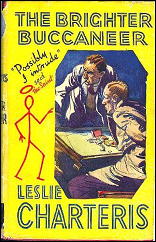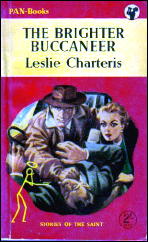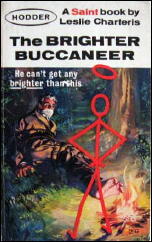Sun 22 May 2011
A 1001 MIDNIGHTS review: LESLIE CHARTERIS – The Brighter Buccaneer.
Posted by Steve under 1001 Midnights , Reviews[4] Comments
by Art Scott

LESLIE CHARTERIS – The Brighter Buccaneer. Doubleday Crime Club, hardcover, 1933. First published in the UK: Hodder & Stoughton, 1933. Reprinted many times, often [warning] with some stories not included.
Leslie Charteris’s long-lived and internationally popular character, the Saint, has appeared in two widely different sorts of tales. In the novels, he is the piratical adventurer and self-appointed executioner, usually involved in melodramatic thrillers with lots of action and political intrigue. The Saint short stories, however, tend to be more jocular and subdued, and often have elements of genuine detection.

Charteris has made one particular sort of short story his specialty — the “sting” story, in which Simon Templar outcons the con men. In doing so, he makes good the losses of the previously fleeced-in line with his reputation as “the Robin Hood of Modern Crime” — and pockets a nice profit for himself in the bargain.
Several of the stories in this collection are classics in this genre. In “The Brain Workers,” for instance, Templar adopts his favorite disguise as twittish Sebastian Tombs to outwit one Julian Lamantia, dealer in phony oil stock; in the final story, “The Unusual Ending,” Lamantia comes in for another dose of the same (this time he’s running a Ponzi scheme). “The Unblemished Bootlegger,” a tale of poetic retribution, is noteworthy in that it marks the debut of Peter Quentin, who became one of the Saint’s regular accomplices in later stories.

“The Appalling Politician” provides a break from the con games. It is a detective story, in which the Saint’s long-suffering adversary, Chief Inspector Claude Eustace Teal, calls on Templar to help out with a stolen-treaty problem. In this one, as he often does, Charteris makes use of his fictional alter ego to get off a few witty blasts at pompous British politicians.
The best of all the stories is “The Green Goods Man,” in which Templar neatly turns the tables on a counterfeit-money scam artist. It has two truly memorable scenes and a slick double-twist ending.
———
Reprinted with permission from 1001 Midnights, edited by Bill Pronzini & Marcia Muller and published by The Battered Silicon Dispatch Box, 2007. Copyright © 1986, 2007 by the Pronzini-Muller Family Trust.
May 23rd, 2011 at 2:46 pm
That’s an interesting observation, Art, about the difference between the book-length adventures the Saint is in, and the short stories.
I hadn’t quite thought of it that way myself, but once you’ve pointed it out, it’s rather obvious.
I read the short stories a long time ago, back when they appeared one by one in the SAINT MAGAZINE. Except for THE SAINT IN NEW YORK, which I also read back in the late 50s, I didn’t read any of the novels until quite recently.
They’re really two different types of stories. I’d be hard pressed to come up with another fictional character that you could say that same about. (Others change over time, but not depending on whether they’re in a short story or a novel.)
June 2nd, 2011 at 7:17 pm
I am looking for a Saint story in which he sets himself up for a switch (a bundle of paper substituted for a bundle of money), but “fails” to be distracted by a falling window blind. Can you tell me in which short story collection this is to be found? It sounds like Brighter Buccaneer! Thanks!
June 3rd, 2011 at 6:15 pm
Good news! I found my copy of Brighter Buccaneer this morning and yes! it contained The Green Goods Man, which is the story I was looking for. All is well…
June 3rd, 2011 at 8:19 pm
Thanks for letting us know, Mark. I’m glad you found the answer!